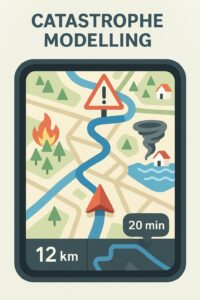Your Underwriting GPS: How Better Data in Cat Modelling is Driving Smarter Delegated Risk Decisions
By Massimo March D’Angelo, Exposure Manager, Carbon Underwriting
 Are You Struggling to Explain Catastrophe Models to Your Wider Team?
Are You Struggling to Explain Catastrophe Models to Your Wider Team?
As catastrophe modelling conference season wraps up, one challenge remains front of mind for exposure management professionals: how to translate the insights from cat models into language that resonates across the business.
If you’ve ever tried to explain catastrophe models to colleagues outside the risk team, it can feel a bit like convincing someone that a GPS is more than just a fancy map.
When questions arise – “Why do we need models?” or “Why not just rely on historical losses?” – this analogy offers a more intuitive way to frame the value of catastrophe modelling.
Making Sense of Catastrophe Models: A GPS Analogy for Risk
In delegated underwriting authority (DUA) business, we delegate underwriting to coverholders who operate across different geographies, perils, and risk appetites. That means inconsistent data, variable risk quality, and evolving exposures. A cat model can’t fix poor data, but it can help bring structure to chaos.
They don’t predict exactly what will happen, but they help you understand the range of possible outcomes based on what could happen:
- Best case: 35 minutes (clear roads)
- Worst case: 90 minutes (major accident on the M25)
- Most likely: Somewhere in between.
Now, imagine trying to plan a journey without a GPS – just relying on memory – that’s exactly what happens when insurers rely on past loss data instead of catastrophe models.
Breaking Down the Cat Model GPS Analogy
- Average Annual Loss (AAL) = Your Expected Journey Time
- The GPS gives an estimated travel time, but it’s an average across many possible journeys.
- AAL is the expected average loss per year – useful, but not the full picture.
- 1-in-100 or 1-in-200 Year Loss = The Worst-Case Traffic Jam
- These are the big, disruptive events – a hurricane, an earthquake, a flood.
- A 1-in-200-year event doesn’t mean it happens every 200 years; it means there’s a 0.5% chance of it happening in any given year.
- Exceedance Probability (EP) Curve = The Range of Journey Outcomes
- The GPS doesn’t give you a single number – it shows a range.
- The EP curve does the same for catastrophe losses, helping us understand the likelihood of different loss levels.
- Tail Value at Risk (TVaR) = What Happens If You Get Stuck
- Getting caught in minor traffic is annoying; getting stuck behind an accident for three hours is a disaster.
- TVaR tells us the average loss when the worst-case scenarios play out.
 Using the GPS Logic to Explain your Case
Using the GPS Logic to Explain your Case
“We haven’t had a major hurricane hit this area in years.”
GPS Logic: “That’s like assuming there won’t be traffic today just because you had a clear drive last week.”
“Why can’t we just use past claims data?”
GPS Logic: “That’s like planning a drive based only on last month’s commute. Conditions change, and so does risk.”
“These models aren’t perfect.”
GPS Logic: “Neither is a GPS – but you’d still rather have a live navigation tool than put your trust in old road signs.”
Underwriting without catastrophe models is like navigating London without GPS. Most days, you might be fine. But one day, you’ll hit an unexpected roadblock – and wish you’d planned ahead.
So you’re explaining the usefulness of catastrophe models, ask yourself, would you rather face a roadblock unprepared on your way to an important meeting, or be prepared with the best navigation tools available?
The Carbon Perspective: Data + Intuition = Better Decisions
At Carbon, we understand that catastrophe models are not foretellers – they’re management tools. In delegated business, where data isn’t always perfect and underwriters aren’t always in the room, the model becomes even more important to standardise decision-making, spot outliers, and quantify risk.
The real power lies in combining advanced models with expert human judgment. At Carbon, we don’t just run catastrophe models – we embed them into a dynamic, data-led strategy that reflects the commercial realities of risk.
In the delegated underwriting space, accessing consistent, structured data across binders and geographies has long been a challenge. Graphene, our proprietary platform, solves that. It captures, cleanses, and standardises coverholder data at scale – giving catastrophe models the quality fuel they need to generate meaningful insight.
Think of Graphene like a GPS for delegated portfolios: continuously tracking the movement of multiple books of business across geographies, classes, and claims. Just as GPS systems absorb real-time input from thousands of drivers to map traffic flow and anticipate roadblocks, Graphene interprets live data signals to surface risk patterns and portfolio performance in real-time – guiding better, faster decisions across the risk landscape.
By enhancing our cat modelling framework with Graphene, we can generate more accurate AALs, detect underreported exposures, and visualise EP curve volatility across portfolios. In short, it helps us model what really matters, not just what’s conveniently available.
This means we’re not just modelling risk better – we’re helping our partners make smarter capacity decisions, price more accurately, and challenge outliers with evidence, not instinct.
So next time your team questions why we need catastrophe models, remind them: You wouldn’t throw away your GPS just because it doesn’t predict every traffic jam, but you also wouldn’t follow it unquestioningly into a lake. That’s why we built Graphene: to make sure our models aren’t navigating with an out-of-date roadmap. Better data, sharper insights, and smarter underwriting decisions – that’s the journey we’re driving ahead with.
Discover how integrating better data and models can elevate your DUA underwriting strategy.
GET IN TOUCH: If you’re interested in finding out more about Carbon, or would like a demo of our data platform Graphene, please reach out at info@carbonuw.com
Get in touch
Please contact our team to discuss how our services can enable your business to grow.





